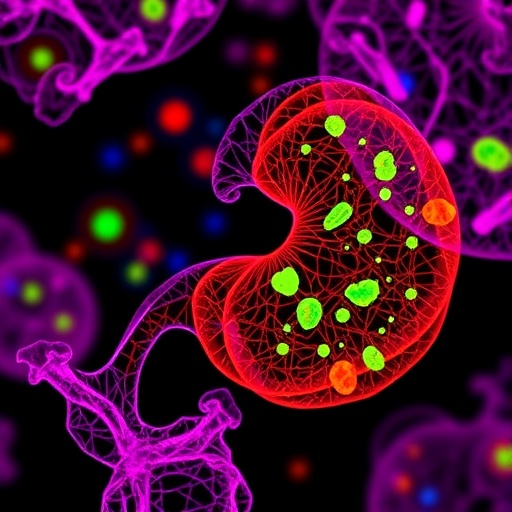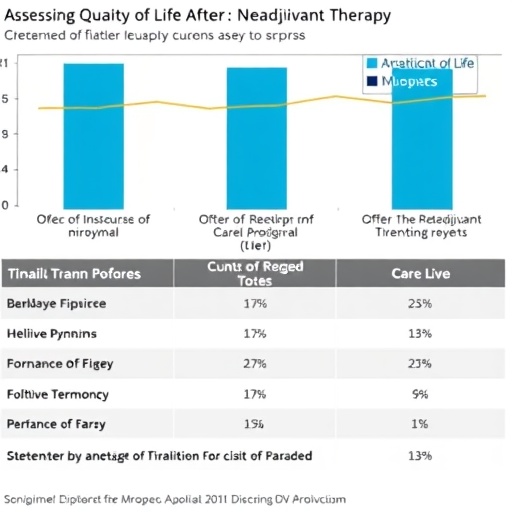In the relentless battle against pancreatic ductal adenocarcinoma (PDAC), the medical community has been continuously confronted by the stubbornly poor outcomes associated with this formidable malignancy. Despite advances in therapeutic regimens, chemotherapy remains the cornerstone of treatment for patients presenting with advanced-stage PDAC. Initial responses to these systemic therapies can sometimes be promising; however, the grim reality is that most patients rapidly encounter disease progression, underscoring the urgent necessity for a deeper understanding of the underlying mechanisms that drive treatment resistance and tumor resilience.
One of the pivotal reasons behind the dismal effectiveness of current therapies lies not solely within the genetic and phenotypic complexities of the cancer cells themselves but critically also in the tumor microenvironment (TME) that envelopes these malignancies. The TME in PDAC is notoriously characterized by a dense, desmoplastic stroma that acts as a physical and biochemical barrier. This barrier significantly impedes the penetration of systemic therapeutic agents and restricts the infiltration of immune effector cells, thereby fostering a sanctuary that supports tumor growth and progression. Consequently, overcoming this formidable microenvironmental obstacle is emerging as an essential strategy in improving patient outcomes.
Recent technological advances have catalyzed a paradigm shift in our exploration of the PDAC microenvironment. State-of-the-art preclinical models now more accurately recapitulate the human disorder, enabling high-resolution interrogation of tumor-stroma interactions. Coupled with this, the advent of single-cell spatial multi-omic technologies has empowered researchers to dissect the intricate cellular and molecular orchestration within the TME with unprecedented precision. Machine learning frameworks further enhance this capability by unraveling complex data layers, revealing hitherto unidentified therapeutic targets and biological vulnerabilities.
A focal point in this evolving landscape is the role of cancer-associated fibroblasts (CAFs), a dominant cellular constituent within the desmoplastic stroma. These fibroblasts are not merely passive structural elements; rather, they actively modulate the immunological milieu, fostering niches that suppress effective immune surveillance and impede antitumor immunity. The phenotypic diversity among CAF subsets and their spatial heterogeneity within tumors contribute to the profound intratumoral and intertumoral variability observed in PDAC, which presents significant challenges but also bespoke therapeutic opportunities.
The categorization of PDAC as an immunologically ‘cold’ tumor has long suggested that immune evasion mechanisms are deeply entrenched in its biology. Innovative therapeutic strategies are now being crafted to convert this ‘cold’ phenotype into a ‘hot’ one, reinvigorating T cell activation and function. These approaches focus on a multipronged assault: priming T cells to recognize tumor antigens effectively, mitigating the exhaustion states that limit cytotoxic T cell efficacy, and disrupting the myeloid-derived suppressor cell networks that enforce immune silence. Such combinatorial tactics are crucial for the successful harnessing of the immune system against PDAC.
Beyond immune modulation, attention is also being directed at the metabolic interplay between tumor, stromal, and immune cells. The metabolic reprogramming orchestrated within the TME not only sustains the malignant cells’ proliferative demands but also shapes immune cell functionality and stromal activation. Identifying convergence points in these metabolic pathways offers the tantalizing prospect of integrated therapeutic targets that could simultaneously dismantle tumor survival mechanisms and rejuvenate antitumor immunity.
The oncogenic KRAS gene, mutated in the vast majority of PDAC cases, remains a central driver of tumorigenesis and an influential architect of the TME. Its signaling cascades dictate multiple aspects of tumor behavior, including cellular proliferation, metabolic remodeling, and immune evasion. Targeting KRAS-driven pathways in conjunction with exploiting vulnerabilities within the TME holds promise for overcoming long-standing barriers in PDAC treatment.
Drawn from a foundation of sobering clinical trial failures, the current research trajectory underscores the indispensable nature of an integrative and nuanced understanding of the PDAC microenvironment. Lessons learned from past setbacks emphasize that successful therapeutic innovations must transcend direct tumor cell targeting to encompass the contextual and supportive roles of stromal and immune components.
The integration of burgeoning single-cell and spatial multi-omics data into robust computational models is revolutionizing our capacity to map the dynamic networks at play within the PDAC ecosystem. These insights are illuminating new avenues for patient stratification, enabling more precise and personalized treatment strategies that account for the unique microenvironmental compositions of individual tumors.
Recent studies have illuminated the dynamic crosstalk between CAFs and immune cells, revealing mechanisms by which fibroblasts orchestrate immunosuppressive niches through secretion of cytokines, chemokines, and extracellular matrix components. Targeting these interactions not only holds the promise of stalling tumor progression but also facilitates the reconditioning of the TME to be more susceptible to immunotherapeutic interventions.
Moreover, the metabolic constraints imposed by the dense stroma, including hypoxia and nutrient deprivation, can induce adaptive responses within cancer and immune cells, shaping their phenotypes and functions. Therapies that normalize the metabolic landscape or exploit metabolic dependencies are emerging as compelling adjuncts to existing treatment modalities.
Encouragingly, experimental therapeutics aiming to dismantle the fibrotic barriers, such as stromal-depleting agents or modulators of fibroblast activation, are progressing through clinical development. However, balancing the dualistic nature of the stroma—as both a supporter and restrainer of tumor growth—remains a complex challenge necessitating sophisticated therapeutic designs.
Immune checkpoint inhibitors, which have revolutionized treatment paradigms in other cancers, have hitherto exhibited limited efficacy in PDAC, in large part due to the immunologically quiescent TME. Novel combination regimens that pair checkpoint blockade with agents modulating stromal or metabolic factors are being ardently investigated to unlock synergistic effects.
Looking forward, the translation of this comprehensive and integrative understanding into clinical practice demands concerted efforts in biomarker discovery, multi-modal imaging, and real-time monitoring of treatment responses. Such advances will be critical in refining therapy regimens to maximize efficacy while minimizing toxicity.
Ultimately, the power to reshape the tumor microenvironment from a fortress into a battleground where immune cells and therapeutics can more effectively engage will redefine the horizon of PDAC treatment. This frontier represents not only a formidable scientific challenge but also an unparalleled opportunity to improve survival and quality of life for patients afflicted with this devastating disease.
Subject of Research: The tumor microenvironment in pancreatic ductal adenocarcinoma (PDAC) and its implications for therapy resistance and immune evasion.
Article Title: The tumour microenvironment in pancreatic cancer — new clinical challenges, but more opportunities.
Article References:
Kung, HC., Zheng, K.W., Zimmerman, J.W. et al. The tumour microenvironment in pancreatic cancer — new clinical challenges, but more opportunities. Nat Rev Clin Oncol (2025). https://doi.org/10.1038/s41571-025-01077-z
Image Credits: AI Generated
Tags: advances in pancreatic cancer therapiesbarriers to drug delivery in PDACdesmoplastic stroma in tumorsimmune evasion in pancreatic tumorsimproving patient outcomes in pancreatic cancerovercoming microenvironmental obstacles in cancerpancreatic ductal adenocarcinoma treatment challengesstrategies to enhance chemotherapy effectivenesssystemic therapies for advanced-stage PDACtreatment resistance mechanisms in PDACtumor microenvironment in pancreatic cancerunderstanding pancreatic tumor microenvironment





